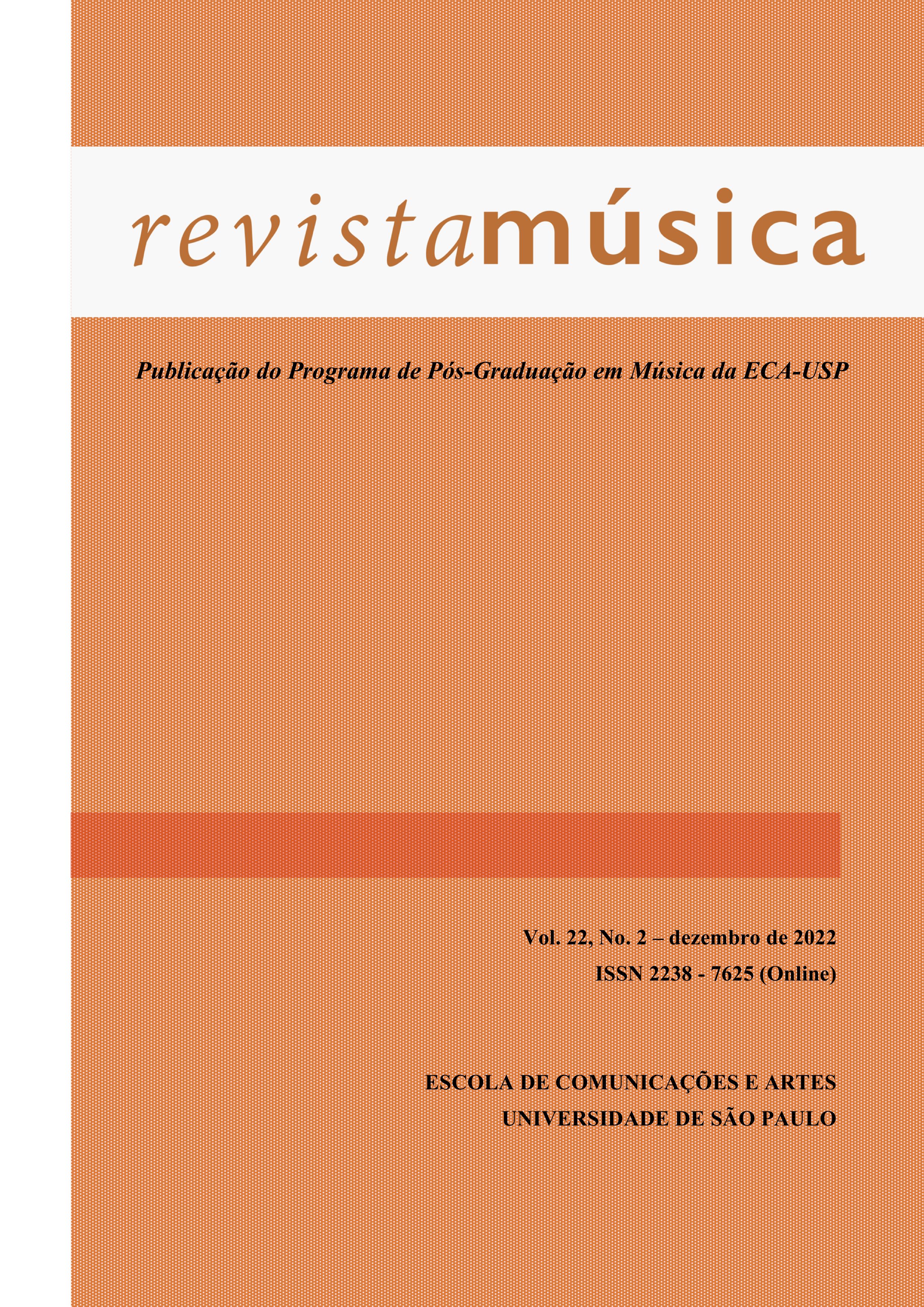Tonal and descriptive statistical analysis of the creational procedures of Tavinho Moura
DOI:
https://doi.org/10.11606/rm.v22i2.200397Keywords:
Post-tonal musical analysis, Compositional procedures, Computational modeling, Popular song, Corner ClubAbstract
This article presents results of a research concluded in April 2022, situated at the intersection of tonal musical analysis, descriptive statistical analysis, compositional procedures, and computational modeling. Based on a sample of songs by Tavinho Moura, composer of the Clube da Esquina, our intention was to identify recurrent musical characteristics which could define his style of creation, within the scope of melody, harmony, and rhythm, defining compositional archetypes to establish a compositional system for Tavinho. We created a computational modeling, making a program that emulates compositions alike to Moura’s, upon MAX/MSP platform. We employed literature review, musical analysis, and descriptive-statistical modeling with computational support. Herein, our focus is concentrated on Moura’s compositional system.
Downloads
References
ALMADA, Carlos de L. O choro como modelo arquetípico da Teoria Gerativa da Música Tonal. In: Revista Brasileira de Música, v. 25, no. 1, Jan–Jun, p. 61–78, 2012.
ALMADA, Carlos de L. Correlações entre frequência de ocorrência e idiomatismo na criação de aplicativos computacionais para composição de choros pixinguinianos. In: Anais do XXIV Congresso da Associação Nacional de Pesquisa e Pós-Graduação em Música, São Paulo, 2014.
ALMADA, Carlos de L., et. al. Composição algorítmica de progressões harmônicas ao estilo de Antônio Carlos Jobim através de cadeias de Markov. In: Proceedings of the 4th International Congress of Music and Mathematics. Rio de Janeiro, Brasil. Federal University of Rio de Janeiro, 2019.
BORGES, Márcio. Os sonhos não envelhecem: histórias do Clube da Esquina. 7. Ed. São Paulo: Geração, 2011.
CANÇÃO. In: The New Shorter Oxford English Dictionary. Oxford: Oxford Univ. Press, 1993.
CARVALHO, H. T. de. An introduction to Markov Chains in Music Composition and Analysis. In: MusMat Journal, Vol. III, No. 2, December 2019, p. 18–43. 2019.
COPE, David. Computer models of musical creativity. Cambridge, MA: MIT Press, 2015.
DINIZ, Sheyla Castro. De tudo que a gente sonhou: amigos e canções do Clube da Esquina. 1. Ed. São Paulo: Intermeios, 2017.
FREITAS, Alan R. R. de. Música Evolutiva: uma abordagem computacional para composição algorítmica. Dissertação (Mestrado), Instituto de Ciências Exatas e Biológicas. Departamento de Computação, Universidade Federal de Ouro Preto, 128 p., 2011.
KOSTKA, Stefan. Materials and techniques of post-tonal music. 5th ed. New York: Routledge, 2018.
MARQUES, Fabricio. Tavinho Moura: um artista exerce seus alumbramentos (Entrevista). In: Revista Suplemento, n. 1.367, Secretaria de Estado de MG, jul./ago., 2016.
MORAES, Pedro Miguel de; PITOMBEIRA, Liduino. Composição do Ponteio No. 5 de Pedro Miguel a partir da Modelagem Sistêmica do Ponteio No. 15 de Camargo Guarnieri. Música Hodie, v. 13, p. 8–33, 2013.
MÚSICA Popular Brasileira (MPB). In: ENCICLOPÉDIA Itaú Cultural de Arte e Cultura Brasileira. São Paulo: Itaú Cultural, 2022. Disponível em: http://enciclopedia.itaucultural.org.br/termo3746/musica-popular-brasileira-mpb. Acesso em: 02 de dezembro de 2022. Verbete da Enciclopédia.
PERRONE, Charles A. “Masters of contemporary Brazilian song”. University of Texas Press: Austin, Texas, 1989.
PITOMBEIRA, Liduino. 2020. "Compositional Systems: overview and applications." MusMat Journal, Vol. IV, No. 1, June 2020, 39–62.
RAMOS, Pedro; AVELLAR, Alexandre; ALMADA, Carlos. Modelização de um choro pixinguiniano para composição algorítmica. In: Anais do XXIV Congresso da Associação Nacional de Pesquisa e Pós-Graduação em Música, São Paulo, 2014.
SARAIVA, Chico. Violão-Canção: diálogos entre o violão solo e a canção popular. Ed. Sesc, São Paulo, 244 p., 2018.
VIEIRA, Carlos Soares F. Pelas esquinas dos anos 70: utopia e poesia no Clube da Esquina. Dissertação de mestrado em Poética. Rio de Janeiro: UFRJ, 1998.
VILELA, Ivan. Nada ficou como antes. Revista USP, Dossiê Música Brasileira, n. 87, São Paulo, USP, p.14-27, set./nov., 2010.
VILELA, Ivan. Canonizações e esquecimentos na música popular brasileira. In: Revista USP, n. 111, p. 125-134, out./nov./dez., 2016.
Downloads
Published
Issue
Section
License
Copyright (c) 2022 Marcio Giachetta Paulilo, Silvio Ferraz

This work is licensed under a Creative Commons Attribution-NonCommercial-ShareAlike 4.0 International License.
Autores que publicam nesta revista concordam com os seguintes termos:
- Autores mantém os direitos autorais e concedem à revista o direito de primeira publicação, com o trabalho simultaneamente licenciado sob a CC Attribution-NonCommercial-ShareAlike 4.0 que permite o compartilhamento do trabalho com reconhecimento da autoria e publicação inicial nesta revista.
- Autores têm autorização para assumir contratos adicionais separadamente, para distribuição não-exclusiva da versão do trabalho publicada nesta revista (ex.: publicar em repositório institucional ou como capítulo de livro), com reconhecimento de autoria e publicação inicial nesta revista.
- Autores têm permissão e são estimulados a publicar e distribuir seu trabalho online (ex.: em repositórios institucionais ou na sua página pessoal) a qualquer ponto antes ou durante o processo editorial, já que isso pode gerar alterações produtivas, bem como aumentar o impacto e a citação do trabalho publicado (Veja O Efeito do Acesso Livre).


